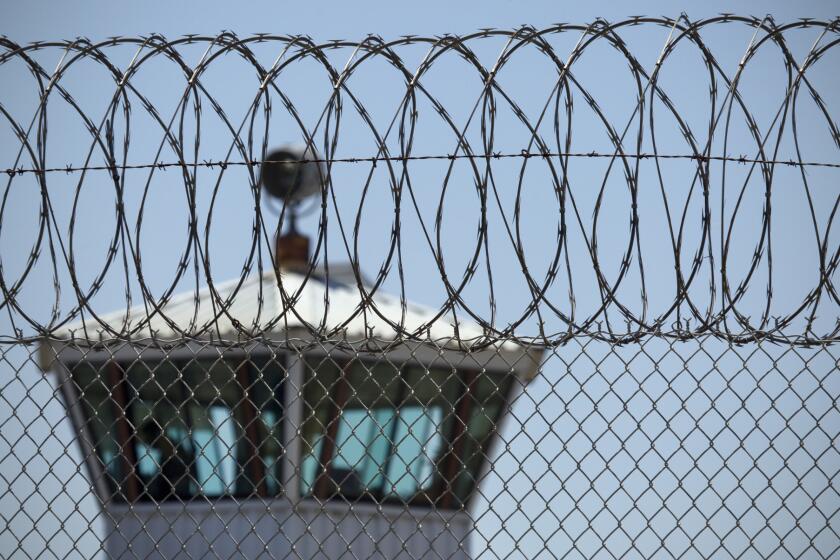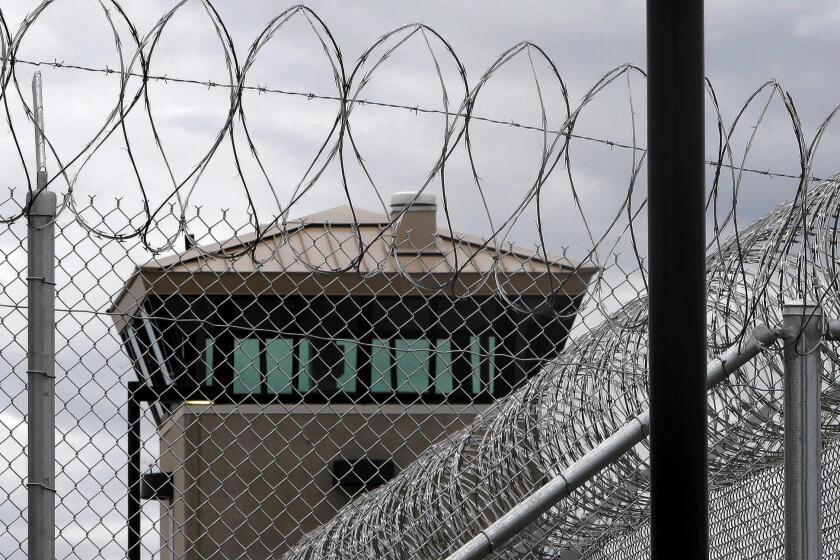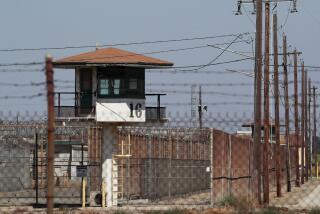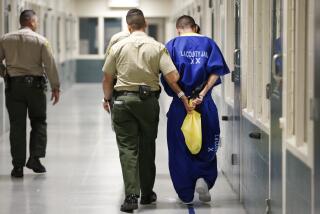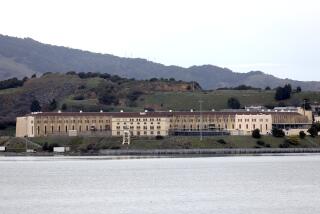1 in 5 prisoners has had the coronavirus, and 1,700 have died
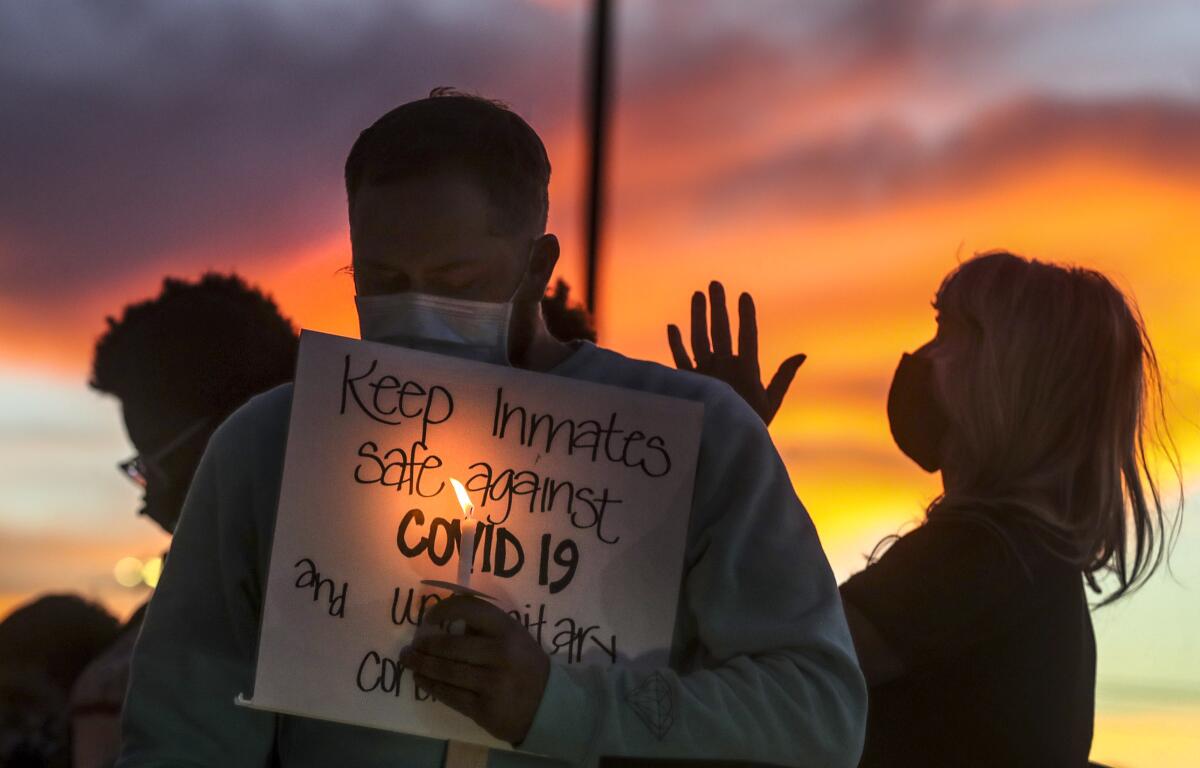
- Share via
LITTLE ROCK, Ark. — One in every five state and federal prisoners in the United States has tested positive for the coronavirus, a rate four times higher than in the general population. In some states, more than half of prisoners have been infected, according to data collected by the Associated Press and the Marshall Project.
As the COVID-19 pandemic enters its 10th month — and as the first Americans begin to receive a long-awaited vaccine — at least 275,000 prisoners have been infected, more than 1,700 have died and the spread of the coronavirus behind bars shows no sign of slowing. New cases in prisons this week reached their highest level since testing began in the spring, far surpassing previous peaks in April and August.
“That number is a vast undercount,” said Homer Venters, the former chief medical officer at New York’s Rikers Island jail complex.
Venters has conducted more than a dozen court-ordered COVID-19 prison inspections around the country. “I still encounter prisons and jails where, when people get sick, not only are they not tested but they don’t receive care. So they get much sicker than need be,” he said.
The rollout of vaccines poses difficult decisions for politicians and policymakers. As the virus spreads largely unchecked behind bars, prisoners can’t social distance and are dependent on the state for their safety and well-being.
Donte Westmoreland, 26, was recently released from Lansing Correctional Facility in Kansas, where he caught the coronavirus while serving time on a marijuana charge. Some 5,100 prisoners have become infected in Kansas prisons.
“It was like I was sentenced to death,” Westmoreland said.
Virus outbreak in past two weeks is among worst in California prison system
Westmoreland lived with more than 100 virus-infected men in an open dorm, where he woke up regularly to find men sick on the floor, unable to get up on their own, he said.
“People are actually dying in front of me off of this virus,” he said. “It’s the scariest sight.”
Westmoreland said he sweated it out, shivering in his bunk until, six weeks later, he finally recovered.
Half of the prisoners in Kansas have been infected with COVID-19 — eight times the rate of cases among the state’s overall population. Eleven prisoners have died, including five at the prison where Westmoreland was held. Of the three prison employees who have died in Kansas, two worked at Lansing Correctional Facility.
In Arkansas, where more than 9,700 prisoners have tested positive and 50 have died, four of every seven have had the virus, the second-highest prison infection rate in the U.S.
Among the dead was 29-year-old Derick Coley, who was serving a 20-year sentence at the Cummins Unit maximum security prison. Cece Tate, Coley’s girlfriend, said she last talked with him April 10, when he said he was sick and showing COVID-19 symptoms.
“It took forever for me to get information,” she said. The prison finally told her April 20 that Coley had tested positive. Less than two weeks later, a prison chaplain called to tell her Coley had died.
California state prisons continue to contend with new, growing outbreaks at multiple facilities amid lapses in tracing, testing, and mask-wearing by guards.
Nearly every prison system in the country has seen infection rates significantly higher than the communities around them. In facilities run by the federal Bureau of Prisons, one of every five prisoners has had the coronavirus. Twenty-four state prison systems have had even higher rates.
Prison workers have also been disproportionately affected. In North Dakota, 4 of every 5 prison staff have gotten coronavirus. Nationwide, it’s 1 in 5.
Infection rates as of Tuesday were calculated by the AP and the Marshall Project, a nonprofit news organization covering the criminal justice system, based on data collected weekly in prisons since March.
As vaccine campaigns get underway, there has been pushback in some states against giving the shots to people in prisons before others.
“There’s no way it’s going to go to prisoners ... before it goes to the people who haven’t committed any crime,” Colorado Gov. Jared Polis told reporters earlier this month after his state’s initial vaccine-priority plans put prisoners before the general public.
Like more than a dozen states, Kansas has a vaccination plan that does not mention prisoners or corrections staff, according to the Prison Policy Initiative, a nonpartisan prison data think tank. Seven states put prisoners near the front of the line, along with others living in crowded settings such as nursing homes and long-term care facilities. An additional 19 states have placed prisoners in the second phase of their vaccine rollouts.
Racial disparities in the nation’s criminal justice system compound the disproportionate toll the pandemic has taken on communities of color. Black Americans are incarcerated at five times the rate of whites. They are also disproportionately likely to be infected and hospitalized with COVID-19, and are more likely than other races to have a family member or close friend who has died of the virus.
The pandemic “increases risk for those who are already at risk,” said David J. Harris, managing director of the Charles Hamilton Houston Institute for Race and Justice at Harvard Law School.
As the country heads into winter with coronavirus infections on the rise, experts caution that unless COVID-19 is brought under control behind bars, the country will not get it under control in the population at large.
“If we are going to end this pandemic — bring down infection rates, bring down death rates, bring down ICU occupancy rates — we have to address infection rates in correctional facilities,” said Emily Wang, professor at Yale School of Medicine.
“Infections and deaths are extraordinarily high. These are wards of the state, and we have to contend with it.”
More to Read
Sign up for Essential California
The most important California stories and recommendations in your inbox every morning.
You may occasionally receive promotional content from the Los Angeles Times.
